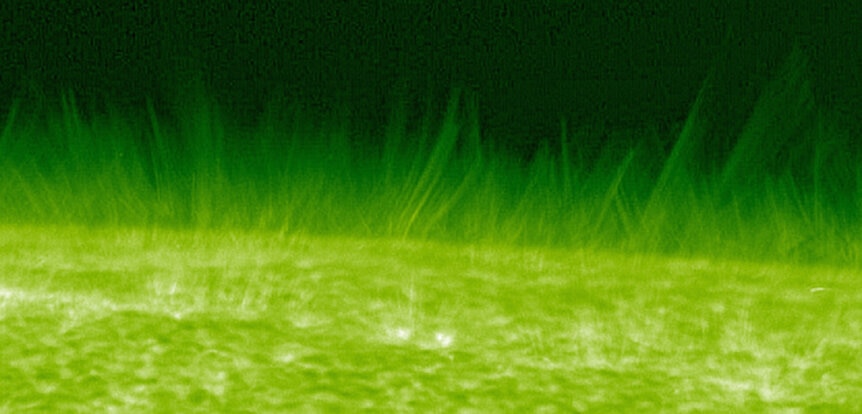Spicules make the Sun look like a shag carpet. We’re still figuring out why
Faraday excitation and alligator mating calls, baby, yeah!

The Sun is literally the closest star to us in the entire Universe, but there’s a lot about it that’s still pretty mysterious.
For example, nearly 150 years ago, the astronomer Angelo Secchi first observed narrow, towering fingers of material stretching vertically away from the Sun. Called spicules, these can grow to a height of 12,000 kilometers — nearly the diameter of the Earth — but tend to be only 1/10th that wide. They grow in a matter of minutes, shooting upwards at tens of thousands of kilometers per hour, then collapse back down.
There are millions of spicules on the Sun at any given moment, and they look like grass or shag carpeting. Time-lapse video of them is entrancing and eerie:
And while they’re known to be associated with strong magnetic fields — typical of phenomena on the Sun — even after all this time it’s not clear what causes them. Paper after paper has been published over the years, with varying degrees of success in explaining these weird features.
A few years ago, a study showed that they may be due to the way the magnetic field interacts with both electrically neutral and charged particles on the Sun’s surface. However, a different team of solar astronomers wondered if there might be a more fundamental piece of physics going on with them. They noticed how fluids can dance when vibrated by the sound waves from a speaker — here’s a good video of that — and thought there might be a connection. When the surface of a fluid is vibrated you can get neat patterns in it as waves get pumped up by them, but as the frequency gets higher there’s a critical frequency when the surface starts to create jets of water shooting up. This type of motion is called Faraday excitation or Faraday waves. Usually in water or other liquids the top of the jet breaks off into a droplet that then falls back to the surface.
This type of event is common in nature; in fact alligators use a low-frequency mating call that can cause it to happen in the water around them, shown in this video about 20 seconds in.
The Sun’s surface is a plasma, mostly hydrogen that’s so hot the atoms have lost an electron, and is dense enough to act like a fluid. Also, there are plenty of sources of vibrations in the solar surface. Deep inside the Sun there’s a layer where extremely hot material rises buoyantly, and when it gets to the surface it cools and falls back down. This is called convection, and there are many towering convective conveyor belts transporting material up and down in the Sun. This causes a continuous rumble on the surface at a frequency that could excite Faraday waves.
The new research [link to paper] first shows that the physics of Faraday waves in the Sun and in a fluid dancing on a speaker are similar. They then experimented in the lab with various fluids to see if they could mimic spicules. They found that a diluted mixture of a polymer (specifically polyethylene oxide) when placed over a speaker can create jets very similar to spicules, and when diluted at the right amount the droplet creation is suppressed as well. Spicules don’t make droplets, so given that the math is similar to describe both effects, there could be some physical similarities.
They then turned to software that simulates the behavior of the solar plasma. Using the known physics of how it behaves, the code can be tweaked to see if certain behaviors can be reproduced. Without any real detailed inputs — just using the vibrations of the solar surface created from sound waves of certain harmonic frequencies — their code reproduced spicule-like structures. That’s encouraging! They also found the driving frequency doesn’t need to be harmonic (that is, sound waves of evenly divisible frequencies, like say 440 and 220 and 110 Hertz), but can be quasi-periodic; mostly periodic but with some randomness thrown in. That’s good too, as the Sun’s surface is a cacophony of different frequencies that don’t always create harmonic chords.
When they added a simple vertical magnetic field to their code they found they got even more spicule-like behavior, with about the right heights and widths. The speed of growth was similar, too. The magnetic field introduces an anisotropy, a non-symmetric nature to the surface that helps squeeze the plasma into narrow towers. This is similar for the need of the polymeric fluid to be diluted; that also is an anisotropy that helps the jets form.
The overall conclusion is that they found a more fundamental reason spicules might be produced on the Sun without the need for lots of special circumstances. This doesn’t mean earlier research was wrong, necessarily, but it can be nice to reach for more basic physics sometimes to see what it contributes, and then add layers to it.
And, like the earlier attempts to explain spicules, it’s hard to know if this is the right answer. Just because the experiments and code make something that looks like spicules doesn’t mean that’s what’s going on.
As I like to point out, this is the nature of science. We usually wind up with lots of ideas to explain a phenomenon, and it can take a while to weed out which ones are actually involved and which aren’t. The Sun is a nightmare of complexity, and a lot of its behavior is incredibly difficult to understand. But we now have observatories like Hinode and Solar Dynamics Observatory and the Inouye Solar Telescope that can see the Sun in high resolution and at wavelengths of light our eyes can’t see, and all these observations help the theorists figure out what’s what.
As time goes on, we’ll understand the Sun better and better. That too is how science works.






























